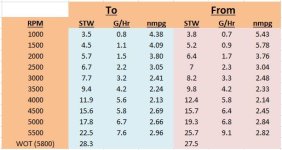JamesTXSD
Active member
- Joined
- Mar 1, 2005
- Messages
- 7,494
- Reaction score
- 1
- C Dory Year
- 2007
- C Dory Model
- 25 Cruiser
- Hull Identification Number
- TBA
- Vessel Name
- "Wild Blue" (sold 9/14)
Some leisurely cruising today: 26.8 miles according to the GPS, 4.2 gallons of fuel used, according to the fuel flow meter. Trying for best economy, I kept RPMs at 1800 max, which resulted in speeds from 5.5 to 6.4 knots. That works out to 6.38 mpg... as long as you aren't on a schedule. I used the autopilot for a good portion of the day, idled around while we watched the dolphins for a while, tossed out the anchor and shut down for lunch, but mostly we just enjoyed the beautiful day and being out on the water.
While our landlubber friends would be appalled with 6.38 mpg, it seems pretty darn good for a boat. Of course, not the "hair blowing in the wind" (maybe that's where my hair went?), spray flying scenes you see in most boat advertisements, but what a nice day.
While our landlubber friends would be appalled with 6.38 mpg, it seems pretty darn good for a boat. Of course, not the "hair blowing in the wind" (maybe that's where my hair went?), spray flying scenes you see in most boat advertisements, but what a nice day.

